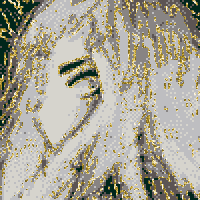
Deus (デウス) ★★★★☆
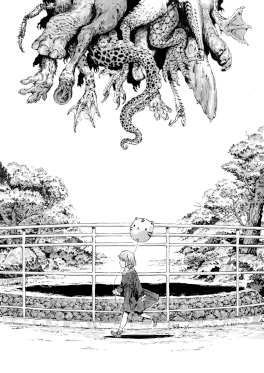
Cool short little Ito-esque eldritch horror.


Cool short little Ito-esque eldritch horror.
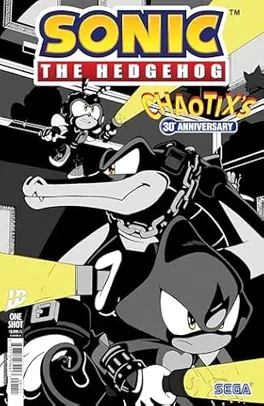
I was disappointed that the Knuckles’ Chaotix designs weren’t used here in line with the the other 30th anniversary comics. Still a fun a little story using the different art styles and character voices to pleasing effect and putting in a bit of light de-colonial subtext on a type of story that generally does not question the institution of the museum itself. Also I feel that the title should have been styled as Chaotix’ 30th Anniversary.

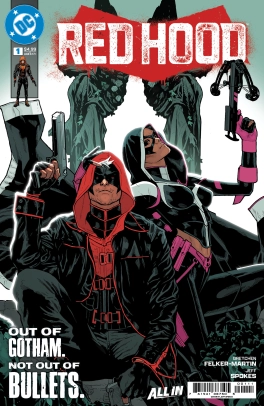
Fuck D.C. for being cowards.
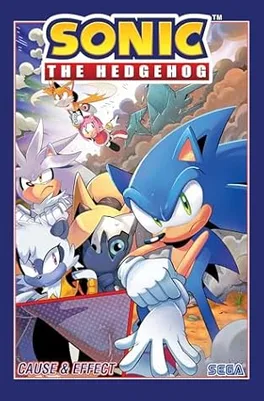
The 2024 annual feels a little insubstantial, mostly being setup for upcoming storylines, but I always appreciate some more of Surge and Kit and Sonic flirting with Knuckles was fun. A lot issues #76 to #78 is also setup but in a way that is picking up the pieces after the big bang in #75 and setting up new directions for things a bit more. Lot of cute moments here too. Belle in her wagon house with Motobud, Amy thinking Blaze is so stoic standing stop the Tornado while she’s actually shitting herself, the big group hug with the girls and the gays and Silver the Hedgehog. All the locations are, of course, gorgeously rendered and I love the race sequence between Blaze and Surge, and the way they use the trails to contrast Surge’s chaotic nature with Blaze’s careful control.
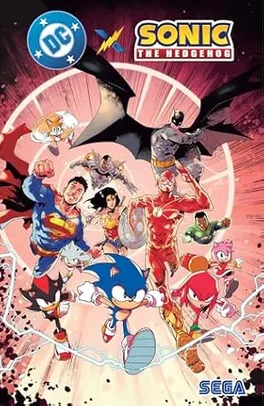
Even putting aside my dislike for the naming scheme that simply labels it as a cross promotion and nothing else—art is ever more stripped to branding exercises not even trying to promise substance—I find it so strange that the title uses the brand name DC itself and not the Justice League. Is the name of the company really more of a draw or recognisable than the actual Justice League themselves? Do people get excited just hearing “DC”?
Still, this is about as good as it could have been. It’s very pretty (other than the superhero costumes the Sonic characters end up in which look atrocious on them), it has a snappy pace with each issue establishing a new set of ideas to play with before quickly moving on to set up the next one, and it has a few good gags and some charm to it. I especially like the bit in the first issue of the Justice League asking how the hedgehogs got their powers only for Sonic and Silver to say that they’re just normal men.

Vols.: I, II, III, IV, V, VI, VII, VIII, IX, X, XI
Your musical entertainment:
A look at how creative decisions and compromises get made on a movie set.
You see, there’s a scene in that movie that tormented me, that kept me up at night, and that lately has had me interrogating a wide variety of seemingly devoted, and certainly well-compensated, filmmaking professionals. That’s because the bird in Charlie’s Angels is, I believe, the wrongest bird in the history of cinema—and one of the weirdest and most inexplicable flubs in any movie I can remember. It is elaborately, even ornately wrong. It has haunted not just me but, as I’d later learn, the birding community at large for almost a quarter of a century.
My clone recently discovered Worst Girl Games and has been having a time of it. When I played it I actually didn’t click with Heaven Will Be Mine nearly as much as We Know the Devil but Caoimhe’s words on it are making me want to revisit it.
Heaven Will Be Mine is short and sweet. A full playthough is roughly five hours. Within that time, it packs a narrative of the trans struggle for identity and recognition, the search for meaning in a perpetually hostile world, the never-ending quest of humans’ self-discovery and exploration, and of course cool mechs beating each other up.
Cute little list and led me to this fun interview from Bad Games Hall of Fame with Rebecca “Burger” Heineman and to revisit this interview with Megumi, the programmer of Virtual Lab1 that I had read before.
Not gonna lie I did NOT realise how long Maddy Thorson had been doing Trans-People-Can-Double-Jump Platformers before making this list. Like, I thought that Celeste was primarily her drawing from the twitchy platformer style of Super Meat Boy but as it turns out, lmao nope Not only does Jumper predate Meat Boy by sevaral years, but the lead character, Ogmo, went on to appear as a playable character in Super Meat Boy, acknowledging the influence that game had taken from Thorson’s work. Like, I fully had the order of cause and effect completely wrong here.
I swear that I am not going to keep linking to blogs by lifeforms that have been bred for thousands of years to sustain themselves solely on ever-more incomprehensible Doctor Who criticism but I needed to share the chips–soufflé spectrum model of media analysis with the world.
Note how chips becomes synecdoche for an ordinary life, an inescapable pillar of the daily grind as fundamental as work, home, sleep, and commuting. Chips is what the rest of us do.
There’s an inescapable class element to this. Science fiction is often accused, with some justice, of being a middle-class genre; even when it’s militaristic our focus tends to be on the officer class. A good deal of the value of Rose in the first place is that, as a working-class soap opera type of character, she does not at first seem to belong on Doctor Who. Indeed, often that’s part of her quality: in her first episode it’s her experience in her school’s gymnastics team, silver medal, swinging on a chain, that saves the day with straightforward physicality where the Doctor’s talk of Shadow Proclamations and anti-plastic failed to hold sway. Then she’s befriending the lowly mechanics and servant girls who turn out to be key to their respective stories.
A nice little piece laying out some interest aspects of the Transformers series2 through the lens of a particular run of comics including the historically weird handling of gender and how later IDW comics corrected that.
When James Roberts began writing the fan favorite series More Than Meets the Eye, he wanted to explore the subject of Transformer romance. And if Furman said that there aren’t any women on Cybertron, then, well… I guess he’s been left no choice but to declare it the robot yaoi planet! His hands were simply tied, folks.
Look. If Bret Devereaux is going to keep writing articles analysing the practicalities of speculative fiction tropes I am going to keep linking to them.
Complicating this picture further are spare parts. Without the ability to manufacture bespoke spare pairs at scale, keeping these vehicles in operation is going to be very difficult. So we ought to expect to see, alongside an emphasis on fuel efficiency, a preference for robust, easy-to-maintain platforms that use widely available civilian vehicle components, rather than hard to source or scavange military components. After all, asking your local junk mechanic to service the AGT1500 gas turbine engine in an Abrams MBT is going to be a pretty big ask, compared to finding the parts to fix the engine of yet another Toyota pickup.
Damn now I want a vector-based display again.
Everyone who works with interfaces should be looking at these and asking themselves why interfaces don’t look like this. Where did we go so wrong? Where’s the big fuckup where we ended up with like, windows 95 instead of this shit? This is something I have devoted untold and definitely irresponsible brain space to. And honestly, the best answer I have is very simple, but I think also a kind of interesting look at how our tools shape the designs we make.
Wijers doing an extremely important job 🫡
When I watch TV and movies, I sometimes notice web addresses. I’ll usually note them down, and look them up later to see if they’re registered. In most cases, they’re registered by the studio or network or whatever and just redirect to their site. AMC, for example, keeps www.savewalterwhite.com up from Breaking Bad (now 12 years after the series ended, as of the time of writing), and www.cometlist.net up from Halt and Catch Fire.
Quite an old one but recently linked to by Tina. What if your scanned just randomly changed numbers around in the scanned image? What multiple models of scanners from the largest manufacturer in the world did that for years without being fixed? There is also an accompanying video.
In this article I present in which way scanners / copiers of the Xerox WorkCentre Line randomly alter written numbers in pages that are scanned. This is not an OCR problem (as we switched off OCR on purpose), it is a lot worse – patches of the pixel data are randomly replaced in a very subtle and dangerous way: The scanned images look correct at first glance, even though numbers may actually be incorrect. Without a fuss, this may cause scenarios like:
- Incorrect invoices
- Construction plans with incorrect numbers (as will be shown later in the article) even though they look right
- Other incorrect construction plans, for example for bridges (danger of life may be the result!)
- Incorrect metering of medicine, even worse, I think.
First of a series of posts on this blog dealing with the hell that is trying to use Linux while blind.
Linux claims to support blind users here. It even ships the tools. But using them? Getting speech or braille output when you need it most? That’s a punishing mess of driver quirks, missing defaults, audio stack failures, and layers of modern regression hidden under the surface.
Anubis is a piece of software that has become popular for helping block unfriendly crawlers that have been overloading a lot of sites to grab data for neural network training without care for the damage they are doing to the web. It also has an cartoon character mascot that has proven useful for weeding people who like being dismissive pricks.
At some level, I use the presence of the Anubis mascot as a “shopping cart test”. If you either pay me for the unbranded version or leave the character intact, I’m going to take any bug reports more seriously. It’s a positive sign that you are willing to invest in the project’s success and help make sure that people developing vital infrastructure are not neglected.
Seen via a post by Fabio Manganiello going further into Bell’s treatment of people compared to what companies and academia both demand of them now, shared by Xerz and boosted by Jennifer Glauche which also inspired the next post by Elilla.
Reportedly, Kelly and others would hand people problems and then check in a few years later. Most founders and executives I know balk at this idea. After all, “what’s stopping someone from just slacking off?” Kelly would contend that’s the wrong question to ask. The right question is, “Why would you expect information theory from someone who needs a babysitter?”
On the empty promises and dehumanisation of Google.
It’s the little things that bugged me, how people would eat the free candy or have a bowl of cereal and just leave trash and dirty dishes everywhere for the cleaning ladies (contractors) to deal with; more than that the way nobody looked at them or said “thank you”. We Brazilians have a social class for that, a social code underlying that studied invisibility, I knew what this was: these were maids. Servants. The women in my family, my friends at school. The “campus” was pretty open and my then-wife visited it a few times; it creeped the Fuck out of her, the distinction between people and non-people.
Virtual Lab is a body-horror falling-block game that used the Virtual Boy’s 3D effects for the self-insert mascot character’s breasts. ↩
I was going to mention her talking about the distinction between the Budianskian and Furmanist modes of Transformers stories but while she does allude to this she keeps it accessible for those who don’t want to know a bunch of fandom jargon and just mentions the distinction as “robots in space” stories versus “robots in disguise” stories. ↩
Great cover story. Definitely not a vampire.
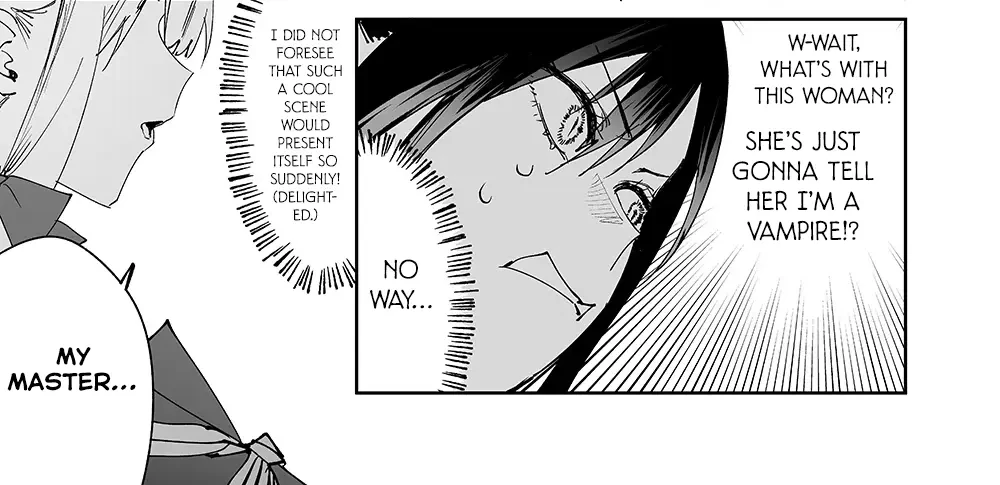
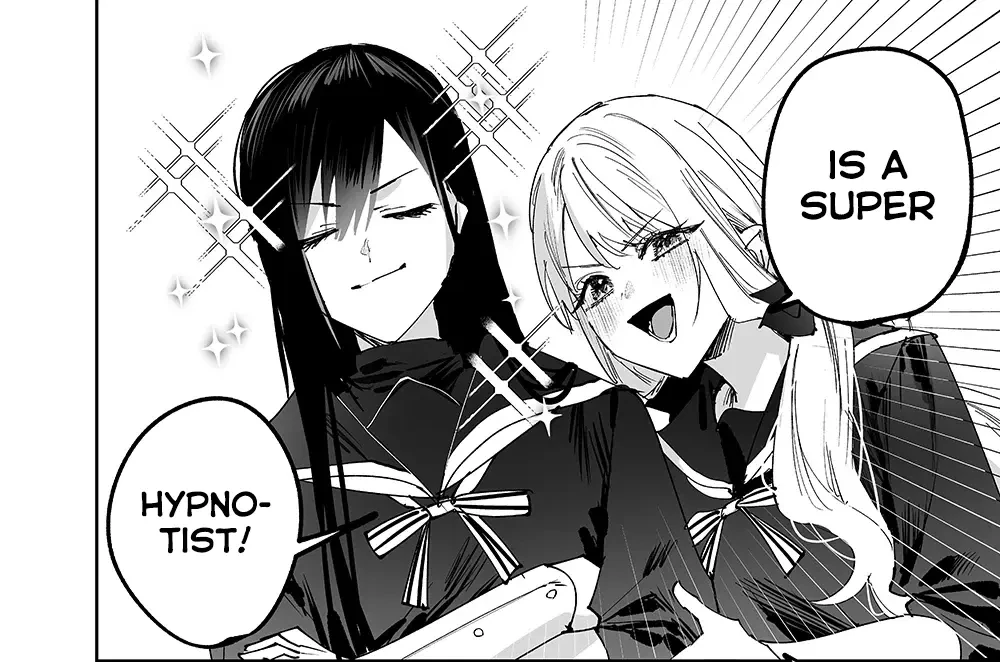
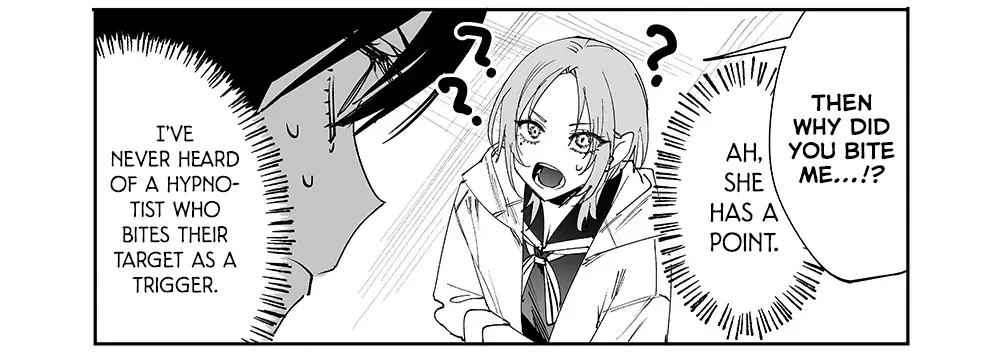
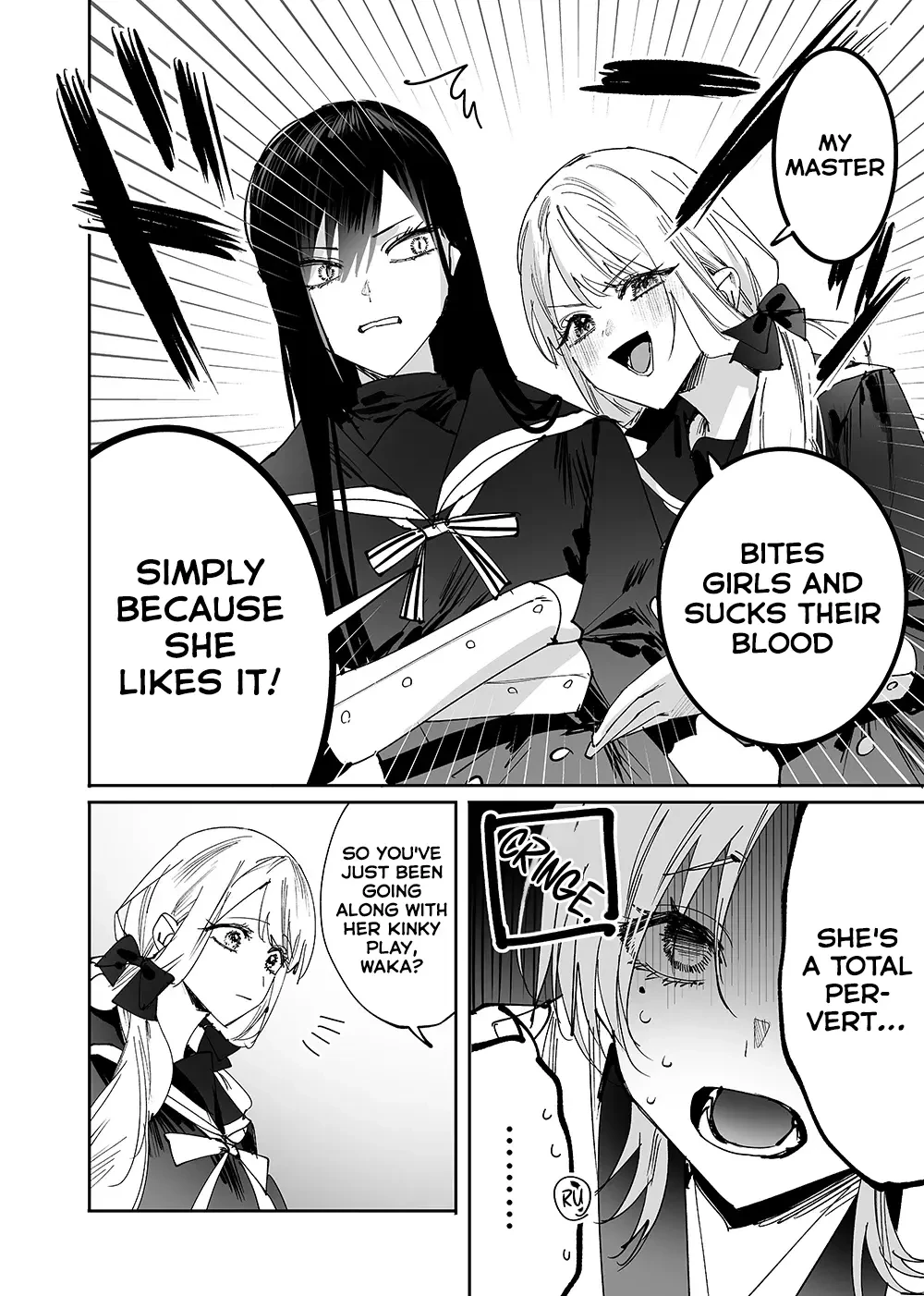
(comic is Girls × Vampire)
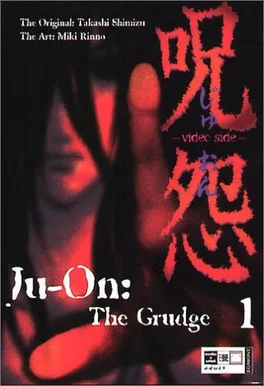
I bought this from a German listing with no photos of the inside of the book. The cover was in English though so I took the risk and hoped it would be in English rather than in German. It was not. I ended up reading it using machine translations with my phone.
Interesting adaptation of the Ju-On: The Curse that eschews the nonlinear structure and ties the characters together more than the original; Mizuho is now the daughter of the realtors who sold the house to the Murakami and Kyoko is her aunt (and also looks very cool). It has a bit more gruesome violence than the movie was able to do with real actors. The gaps in the original film where the events of 4444444444 and In a Corner happen are filled in here with different, bloodier, ends to the characters. Kanna’s jaw getting ripped off, left to the viewer’s imagination in The Curse, here gets shown as Ma commanding stray cats to ram themselves down her throat until it gives way, which means that the Saeki family cat finally gets a kill of its own.
It also, despite the violence she is inflicting, shows Kayako as a more sorrowful character, wanting to end people’s suffering and being anchored, seemingly unwillingly, to where she died, but still aware of what she’s doing.
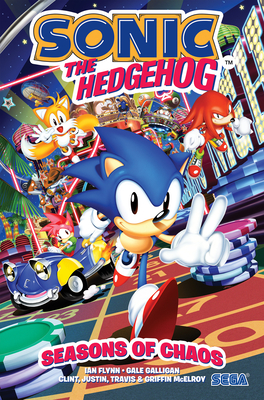
What voice I hear when I read dialogue in these comics varies a lot. When I read the mainline Sonic comics I usually hear Roger Craig Smith’s voice in my head as the hedgehog, but if it’s something where he’s a bit more immature it’s often Bryan Drummond. For Seasons of Chaos it’s Martin Burke from the O.V.A. with a matching Lainie Frasier Tails, but when I turn the page over to Sonic Learns to Drive he’s Jaleel White now. Sonic encompasses a bunch of different tones and styles and this book is a nice collection of some of the lighter stories with the younger versions of the cast.
Seasons of Chaos itself feels like it delivers on the promises of the Mega Drive miniseries that got cut short by the Archie Sonic the Hedgehog comic’s cancellation with an expanded, post-Sonic Mania cast who are also captured so perfectly in Aaron Hammerstrom and Reggie Graham’s art.
Sonic Learns to Drive is goofy fun that feels like it is hitting every single obvious joke to make but it lands them well.
Dr. Eggman’s Birthday and Amy’s New Hobby are two cute stories to end it out on, particularly the latter with its celebration of making your own little comics, which feels particularly meaningful given how much of the staff of the comics came from fan communities in the first place, and stands in stark contrast to how Sonic Boom and that era of Sonic media handled the idea of fan fiction with disdainful self-mockery.
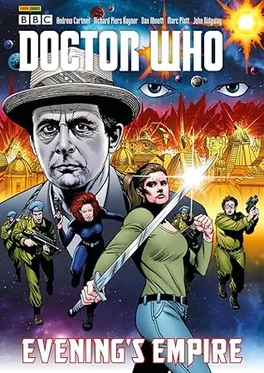
I got this on a whim as part of a three for two offer, being a fan of Doctor Who since the 2005 series but only having seen bits and pieces of the older show and not much in the way of expanded universe material. I enjoyed it. The title story is by far the most substantial, trying to be a condemnation of the misogyny of a lot of sci fi adventure fiction but making the female cast suffer by way of demonstration. Emblematic of the approach is when Ace is told to put on a gold (presumably; the comic is in black and white) bikini, to which her response is to kick a guard square in the chest, steal his sword, and escape, only to quickly fall back into peril and be forced into the slave attire anyway. Much worse things happen to women in the story from there.
The art is impressive enough at times but often falls into uncanny and offputting in ways that extremely realistic styles do. It’s feels like making a comic out of stills taken from the show paused at unfortunate moments mid sentence that make the characters look as bad as possible. Included in this version are some redone pages that might be argued to look better than the originals in isolation, but in practise massively contrast with what’s either side of them in a terribly jarring manner. In the originals you have strict black and white with clear lines and contrast with the redrawn ones done entirely in digital brushes with no sharp lines and a million shades of grey. The contrasting styles could, maybe, have been used to dilettante the reality of Earth with the imaginary construction of the titular empire but that is not how they are used at all. In fact when I saw how the soldiers in fatigues looked in the painted pages I thought it made them look like plastic figurines, which I thought might tie into how Ace describes the empire of stinking of polystyrene cement, but those were the real UNIT troops, not part of Alex’s mindscape.
The second largest part of the book is The Grief which is a fairly middling riff on Aliens in which the Doctor guilt trips a guy into doing a big heroic sacrifice and then leaves him to die, followed by him in The Raven picking up a samurai to bring to the future so that he can murder a bunch of gangsters. I know these stories are trying to be part of an era of constructing the Doctor as a darker, more ambiguous, schemer but it just comes across as petty and mean.
Memorial tries to put this scheming to a better, more touching use, but the backstory being a highly advanced purely good lovely alien species being wiped out by another purely evil alien species seems very unimaginative, especially coming just off The Grief which had the same thing. Cat Litter is kind of fun with the chutes and ladders spread but I felt like I was missing some context reading it, which the commentary at the back of the volume confirmed and I have nothing much to say about Conflict of Interests or Living in the Past.
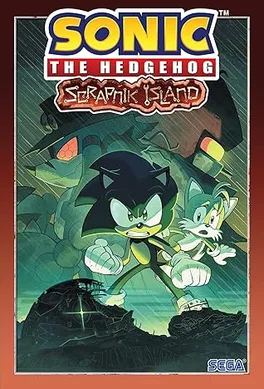
The story is straightforward but effecting and it is brought to life wonderfully in the art, especially Nathalie Fourdraine’s colouring and it’s a masterpiece in the use of light and darkness and it’s just lovely to revisit in in paper. And there’s just so many little details: The boarders changing based on the lighting throughout the comic, getting darker as they venture into the depths of the Death Egg and glitching out in time with Mecha Sonic.
There’s lots of great little moments throughout. I love when it briefly turned into Aliens everything turns green. And Mecha Sonic is just so cool.
I do think Sonic’s injured leg is something that he seems to just get over far too easily in the climax and really nitpicking things a small detail I noticed on reread: Sonic consistently walks putting his weight on his injured leg. I guess this is to make it more visible and prominent, and maybe easier to draw, but once I noticed it bothered me for the rest of the book.
I was in Forbidden Planet and decided it would be nice to have physical copies of some of the prettier Sonic one off stories and then I was told there was a 3 for 2 so I grabbed a random volume of reprinted Doctor Who Magazine comics as well
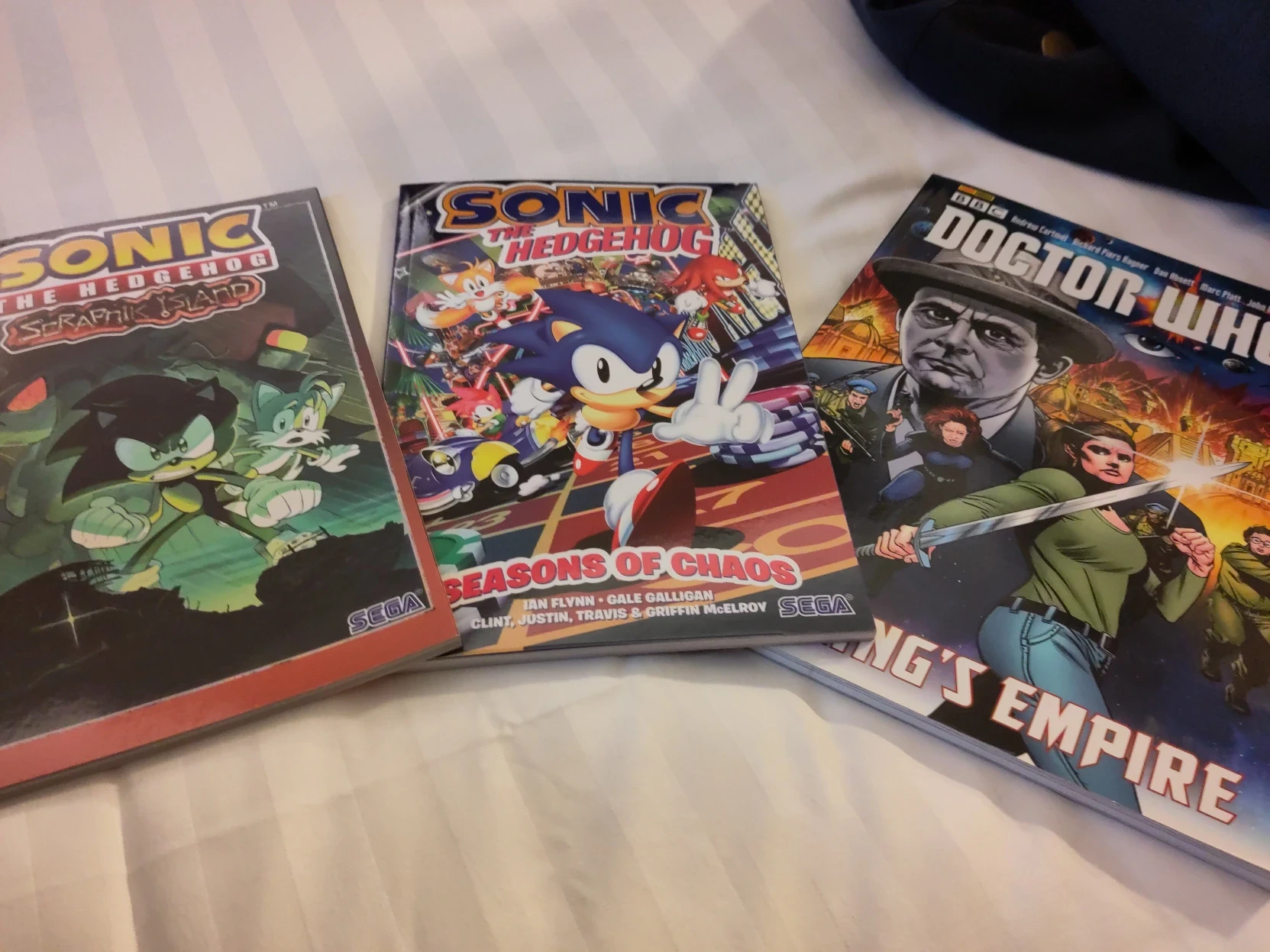
The Nothing Expanded Universe
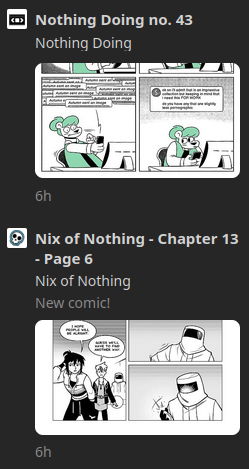

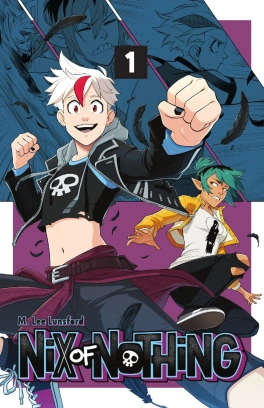
Cute little action story with lovely art. Looking forward to seeing where it goes. Also knows how to seed in stuff about the world without resorting to too much lore dumping.
This lettering is annoying me because I know exactly what mistake was made when typesetting it and it’s consistent through the entire volume.
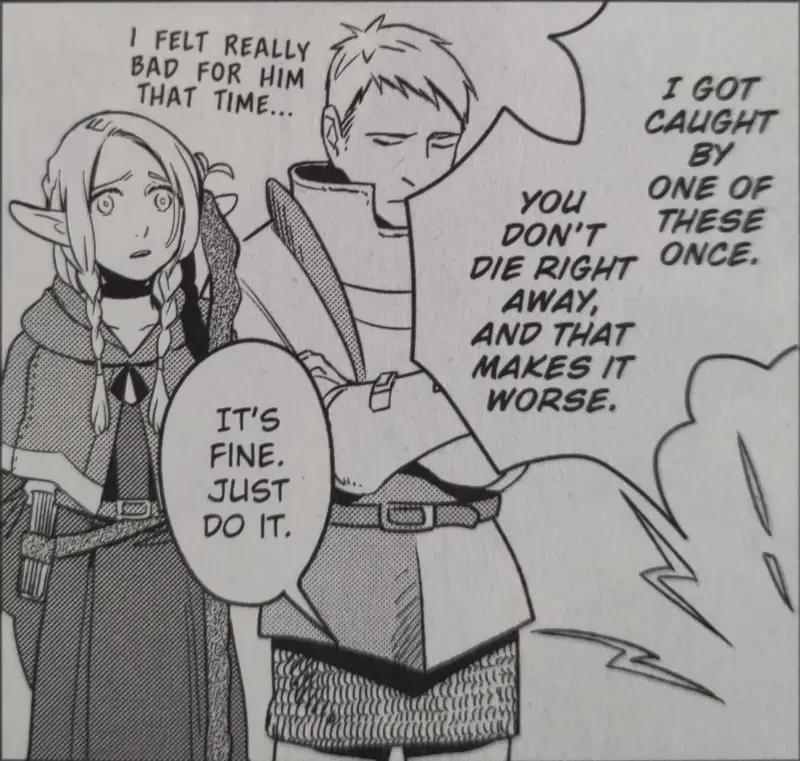
(the i should only be written with serifs when it’s a pronoun, but the font they used encodes this by having the capital i being seriffed, so they’ve ended up writing every sentence that starts with an i with a seriffed i)
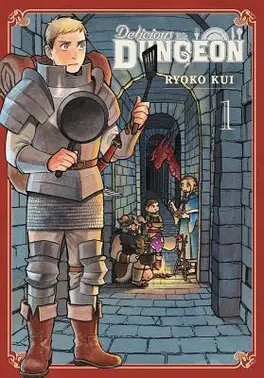
I picked this up on a whim when I saw it in a bookshop that I have a gift voucher for. I’ve watched the show before and enjoyed it so what I’m mostly interested in here is how it works as a comic in comparison to that.
And I do think there’s a lot here that works better on page. Something I’ve never liked in anime is quick cutaways in the middle of dialogue for asides or inner monologue. I think these work better in a comic panel where it’s just a little bit of extra annotation on the page but is almost universally awkward in a show where it’s cut into the middle of dialogue and messes with the flow of conversation. Dungeon Meshi isn’t the worst offender but it’s still not great.
The diagrams that pop up when people are going on a bit of a monologue also work a lot better when you can take time to sit on them, and especially the panels where the meals are shown off after cooking. The extra details of listing out the ingredients and nutritional information really adds to it (and as for the show’s version of that, I am a hater when it comes to overly shiny anime food, shit looks like it’s made of plastic half the time).
That said, the actual cooking sequences do benefit from getting to be animated. Those little montages of methodical preparation are satisfying. The actors in the show are also really good. I am fully just hearing the actors from the show in my head as I read. Except Falin. I never liked her voice. Sorry. (I watched it in English, mostly).
Then there are some issues I take with how they’ve lettered this in English. They have used a comic font with a seriffed I on the uppercase and a sans serif I on the lowercase. This is a standard way of encoding a comic font but the serif I is only meant to be used for the pronoun I and acronyms but they have clearly just typeset it by typing in the sentences normally, so any sentence that starts with I has it seriffed when it shouldn’t be. They also use a different font for asides which doesn’t have a seriffed I.
And then the onomatopoeias are awkward. It seems like some of them have been redrawn but most of them they have just scribbled in a transliteration followed by an attempt at an English approximation in brackets under it. Maybe that’s the standard way to do it?—I don’t read much manga—and I don’t know what would be the ideal approach would be but this way strikes me an awkward middle-ground that clutters the page and slows down my reading.
I think I will just wait for the show to come out and watch it as it does rather than continue reading this, though.

Because I like to keep my ebook library organised and American comics are a mess when it comes to sensible making a series straightforward to follow I have been maintaining my own reading order for the IDW Sonic the Hedgehog comics for a while. I have intended to add this to my site for a white and the current Sonic comic Humble Bundle seemed a good excuse to finally do it.
I intend to keep this as a live document that I update as new issues come out and have it as something that I can point to people when I try to convince them to read it and they don’t know where to start. If you want to start from the beginning that Humble Bundle has the first eight volumes for €12.38 and for €1 it has Scrapnik Island which is a great self-contained story to get a taste of the series with.
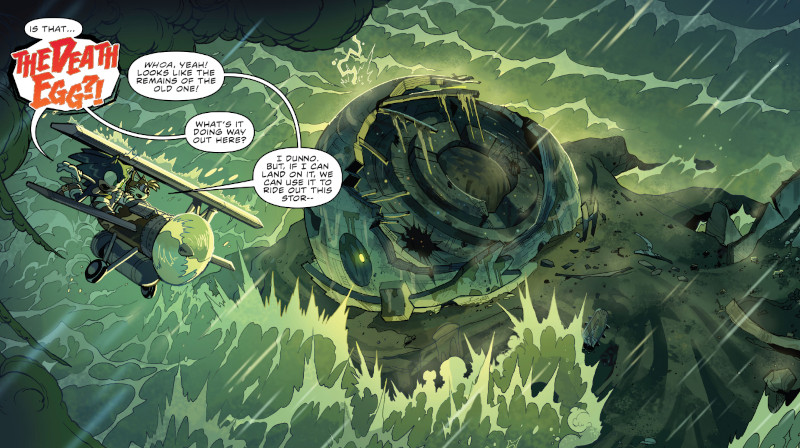
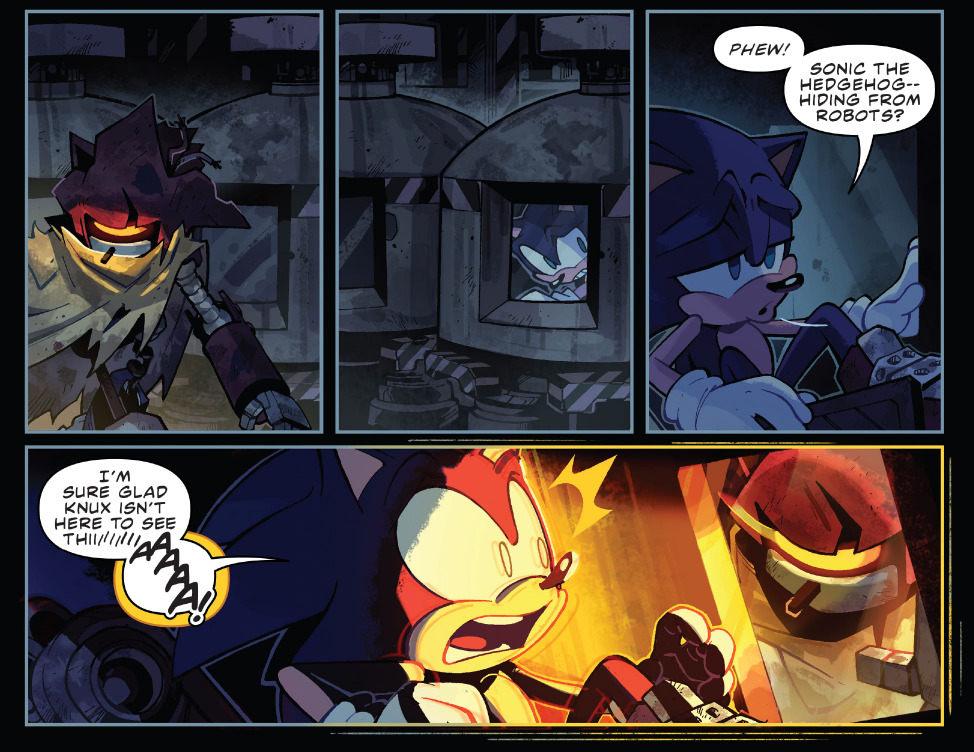
If you looked at my reading order you might have noticed I had the Tangle & Whisper miniseries in the middle of the eight volumes offered in the bundle but rest assured that they are perfectly understandable without it. It’s not until further along in the series that the story of that miniseries is really built on more.

Vols.: I, II, III, IV, V, VI, VII, VIII, IX, X, XI
The longer we tolerate the little lies that robots tell us, the bigger the lies become, and the more difficult it becomes to untangle them from our everyday lives. This is not an inevitability, however; we can find in ourselves and in our connections with eachother the self-confidence to learn how these things work, to unpick the threads, to see through the smoke and mirrors that they are only barely veiled behind.
Always remember to Post Hog.
And yeah, sometimes I want to do that, if I’m writing about my experience playing a game or something, but I also have a HUGE list of ideas for blog posts that I plan to write “eventually” that I’m very much not posting because I think I don’t have time to do it right. Because I think it has to be some level of “interesting” or “good” or “having a point.”
I’ve forgotten the lesson of Post Hog.
I am honestly mostly linking to this for the absurdity that is the comparison image that Open AI used to show how “DALL·E 3 significantly improves uon DALL·E 2”. Look at this:
The older one looks somewhat like an actual oil painting while the “improved” version is a cacophonic mess that fails to represent what it asked of it while being aesthetically ugly as shit.
It almost makes me think that perhaps generative AI could actually produce output that is meaningfully better than it currently does and is at least partially hampered by simple obstacle that people who are making and curating these systems have truly atrocious taste.
The cookie example doesn’t seem to be on the site any more but the comparison they’ve replaced it with shows the exact same problem.
The PC fan CR box was a recent invention to find a method to achieve high clean air delivery rates with very low noise. Noise is the greatest limitation of in-room air cleaners and PC fans are the best option to address it. There are no other air cleaners on the market that have the capability to supply 150 lps of clean air at 35 dBA. Nothing comes close.
Via House of Nettles. I am also still following Natalie’s posts about reblogging and keen to try my hands at doing similar with this site now that my rewrite to make posting easier is done. Also also from Natalie: This amazing look.
A distilled history of the TERF movement and its roots in reactionary feminism.
For the twenty-first-century feminist who has never heard of this schismatic moment and has perhaps swallowed the narrative that transphobia and biological essentialism were intrinsic to feminism’s Second Wave, reading the movement magazine the Lesbian Tide is an education. Morgan’s keynote was reprinted in the May-June 1973 issue but placed at the back in small type, sandwiched between contributions that all criticize Morgan and oppose her sabotage of the gathering. MacLean’s diary conveys participants reactions to the conflict on stage: “This can’t be happening. This woman is insisting that Beth Elliott not be permitted to perform because Beth is a transsexual.” “That’s bullshit! Anatomy is NOT destiny!” In her own contribution, “Of Infidels and Inquisitions,” Elliott testifies that the solidarity she experienced “kept alive my faith in womankind.” Concerning Morgan herself, however, she states with dignity that “I personally distrust those who hate men more than they love or do anything positive for women.”
Via the Internet Archive, via Emma Zhou, via Peter Krupa via a reblog from Sin Vega.
This fairly mild and nothing that hasn’t been said over and over again, but it’s still sort of nice to hear it directly from Alan Moore?
Soon thereafter, caught up in the rush of adolescent life, I drifted out of touch with comic books and their attendant fandom, only returning eight years later when I was commencing work as a professional in that fondly remembered field, to find it greatly altered. Bigger, more commercial, and although there were still interesting fanzines and some fine, committed people, I detected the beginnings of a tendency to fetishise a work’s creator rather than simply appreciate the work itself, as if artists and writers were themselves part of the costumed entertainment.
A short story about being groomed on Tumblr. Mind the content warnings.
Friendly reminder that not inviting vampires into your house is viviocentrism. Stop being viviocentric!
OP, I don’t want to demand more emotional labor from you, but I really don’t understand what you mean. Should I really invite in every vampire?
Disrespectfully, go fuck yourself. It’s not my job to educate you.
ᵃʷᵒ°
ᵃʷᵒ°
ᵃʷᵒ°
See, this is exactly the sort of bullshit that living “allies” always impose on us. OP made it extremely clear: Not inviting in a vampire is viviocentrism. INVITE IN EVERY VAMPIRE.
You may think that nested quote looks horrendous but I am just providing the genuine 2010s Tumblr experience.
Edwin pulls together multiple articles that are worth reading in and of themselves to look at how Space Marines have been sanitised away from their satirical roots.
It’s saying something about how accustomed I am to the ostensibly parodic figure of the Space Marine being portrayed as a hero that I didn’t really question this desire to make you “like” and “get” the “fanatical killing machines” at the time. To be clear, I don’t think Saber are deliberately and consciously trying to kindle empathy for literal fascist enforcers in Space Marine 2. Much of the above reasoning is grounded in ostensibly neutral, best-practicey questions of craft and characterisation.
An old classic that I think about a lot. I hope Stephy Rei Holiwell is still doing well out there. This and some other now-deleted writing of hers meant a lot to me.
Games about killing should probably make you uncomfortable. They shouldn’t be carefully crafted to be pleasant. Metroid II is openly about killing. It makes me uncomfortable with wordless specificity. This is one of the game’s saving graces.
This article was also, I believe, a large and overlooked part of the critical re-evaluation of Metroid II, being the basis for Game Maker’s Toolkit’s appraisal of the game when discussing its remakes.
An extract from someone’s memoirs published in a local paper. I don’t think the book would be the most interesting thing in the world if I’m being honest but I found some of the quoted letters to an agony aunt column amusing.
We are four worried 17-year-old teenagers. We are going to our first dance soon and a friend has told us to refuse a mineral from a boy because if you accept it you are supposed to spend the rest of the dances with him. We would like to know if this is true. Also, if a fellow asks you to go outside does this mean that he is bad? And what should you do if a boy asks you to go outside?
And to explain the terminology: An agony aunt is someone who pens an advice column and mineral here means soft drink or soda. Sorry if I ruined the picture in your head of teenagers in the 1960s exchanging rocks at a dance.